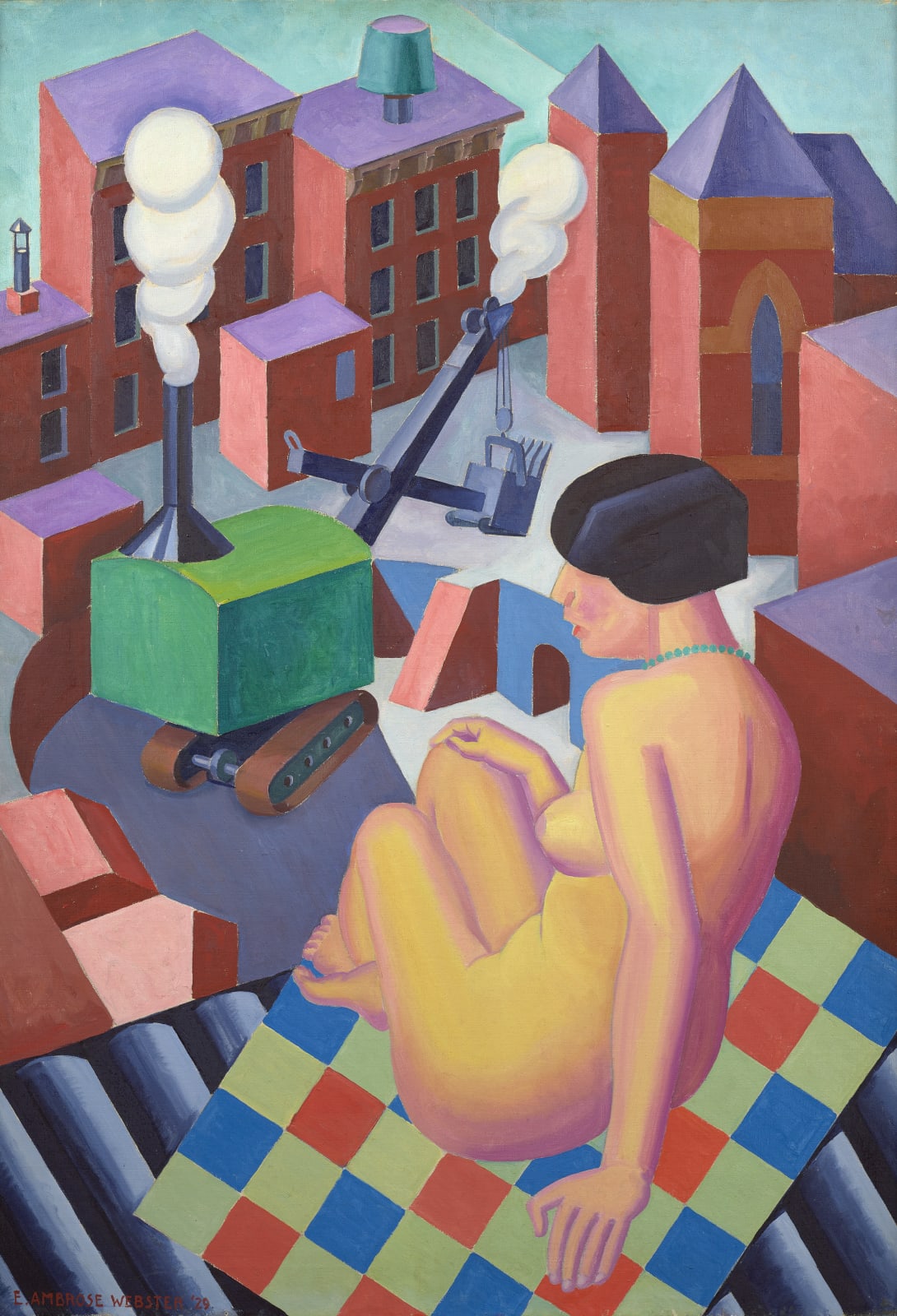-
E. Ambrose Webster
Greenwich Village in Geometry, 1929Oil on canvas45 3/4 x 32 inches
116.2 x 81.3 cmSigned and dated at lower left: E. AMBROSE WEBSTER '29E. Ambrose Webster was a pioneering American Modernist who introduced a new visual language that combined innovative color theory with an analytical approach. Born in Chelsea, Massachusetts in 1869, Webster...E. Ambrose Webster was a pioneering American Modernist who introduced a new visual language that combined innovative color theory with an analytical approach. Born in Chelsea, Massachusetts in 1869, Webster had distinguished family history—his father was related to Daniel Webster and his mother descended from Ralph Waldo Emerson. He studied at the Boston Museum of Fine Arts under Frank Benson and Edmund Tarbell prior to travelling to Paris to study at the Académie Julian in 1896. Webster went abroad to advance his artistic training like many American artists at the turn of the century and abandoned the dark academic style that he had mastered in favor of a colorful palette inspired by the Fauves, drawing inspiration from Henri Matisse. He became known as one of the earliest American Fauvists and submitted two brightly hued landscapes to the famous Armory Show of 1913. Webster was also strongly influenced by Cubism, having studied under Albert Gleizes and Jean Metzinger in 1918. Upon his return to America, Webster gave up the cosmopolitan lifestyle and chose instead the small town of Provincetown, Massachusetts. Inspired by the unique quality of seaside light and color, he created an artistic legacy on a more regional scale. He was a founding member of one of America’s oldest art colonies in the Provincetown community and opened the first modernist art school there which he ran for thirty-five years.
Painted in 1929, Greenwich Village in Geometry exemplifies Webster’s large-scale masterworks of the late 1920s. In Gail Scott’s in-depth study of the artist’s career, Ambrose Webster: Chasing the Sun (2009), she describes the mature process the artist employed for the present painting: “From this point onward, composition and line assume paramount importance in the artist’s figural work and in his teaching. In his figurative work, along with an emphasis on linear, abstracted composition, came a new working method in the form of extensive preparatory drawings and small studies leading up to one or more finished versions in oil . . .” His working method also reflected Jay Hambidge’s theory of Dynamic Symmetry, which employed a mathematical system of proportion based on ancient Greek design principles. In Greenwich Village in Geometry, Webster presents a female nude seated on a corrugated roof overlooking a miniature town scene. The interplay of color and form animates the composition as seen in the clustered red buildings, patterned checkerboard mat, and billowing puffs coming from a toylike steam shovel. Interpreted by one critic as a metaphor of the artist’s view of the American scene, this complex composition masterfully conveys Webster’s unique modern vision, applying intense color and geometry to design a dynamic world of his own creation.Provenance
Estate of the artist, 1935; to
Georgianna Webster (the artist's wife); to
Karl Rodgers (her nephew), 1942; to
Allegra H. Rodgers (his wife); to
Delorma Rodgers Morton;
Private collection, New York; to
[Sale: Sotheby's, New York, May 21, 2014, lot 60];
Private collection, New York, until the present
Exhibitions
Linda Hyman Fine Arts, New York, Primary Structures: The American Modernsists' World, October-December 1996 // Babcock Galleries, New York, E. Ambrose Webster, May 2003 // Greenville County Museum of Arts, South Carolina, E. Ambrose Webster: Pioneer Modernist, November 2008-February 2009Literature
Grace Glueck, "Art in Review—E. Ambrose Webster," The New York Times, May 23, 2003 // Gail R. Scott, E. Ambrose Webster: Chasing the Sun, New York: Hudson Hills, 2009, p. 172, illus. p. 169 and back cover
Subscribe to our mailing list to receive updates from the gallery
* denotes required fields
We will process the personal data you have supplied in accordance with our privacy policy (available on request). You can unsubscribe or change your preferences at any time by clicking the link in our emails.

